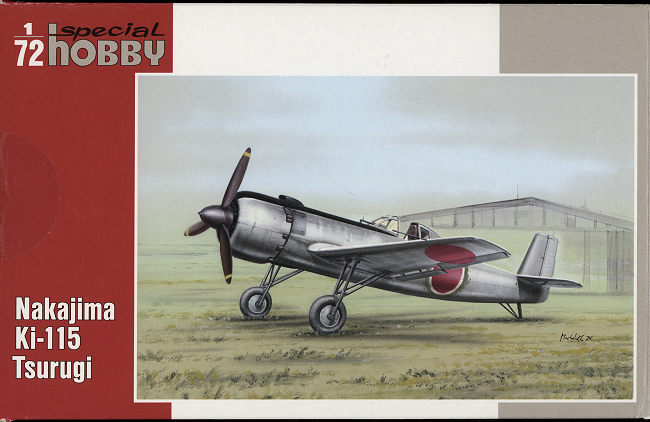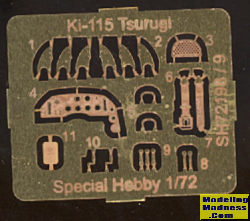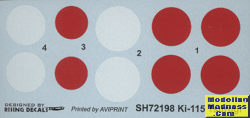
Special Hobby 1/72 Ki-115 Tsurgi
| KIT #: | SH 72198 |
| PRICE: | About $16-25.00 |
| DECALS: | one option |
| REVIEWER: | Scott Van Aken |
| NOTES: | SW |

| HISTORY |
The aircraft's intended purpose was to be used in kamikaze attacks on Allied shipping and the invasion fleet expected to be involved in the invasion of Japan, Operation Downfall, which in the end did not take place.
Because the Japanese High Command thought that Japan did not have enough obsolete aircraft to use for kamikaze attacks, it was decided that huge numbers of cheap, simple suicide planes should be constructed quickly in anticipation of the invasion of Japan.
The aircraft was very simple, being made from "non-strategic" materials (mainly wood and steel). To save weight, it was to use a jettison-able undercarriage (there was to be no landing), so a simple welded steel tube undercarriage was attached to the aircraft. This, however, was found to give unmanageable ground-handling characteristics, so a simple shock absorber was then incorporated. The cross section of the fuselage was circular and not elliptical as were most planes of this size and type; such a fuselage was easier to make.
Tsurugi had an instrument panel with some flight instruments; rudder pedals in addition to joystick type control column, and also a place for a radio. Flight controls included both ailerons and elevators and (in production versions) flaps.
The Ki-115 was designed to be able to use any engine that was in storage for ease of construction and supply, and to absorb Japan's stocks of obsolete engines from the 1920s and 1930s. The initial aircraft (Ki-115a) were powered by 858-kilowatt (1,151 hp) Nakajima Ha-35 radial engines. It is not known if any other engine was ever actually fitted.
After testing the first production aircraft were fitted with the improved undercarriage and two rocket units. These may have assisted with take-off or may have been designed for the final acceleration towards the target.
| THE KIT |
 This is not the first 1/72 Ki-115 kit ever done as I built the decidedly more
crude Aviation Usk short run version some 20 or so years ago. This is a huge
improvement. Those who have built Special Hobby/MPM kits know that they never
make things easy. For so simple a plane you'd thing there would be few parts.
Nope. There is one
This is not the first 1/72 Ki-115 kit ever done as I built the decidedly more
crude Aviation Usk short run version some 20 or so years ago. This is a huge
improvement. Those who have built Special Hobby/MPM kits know that they never
make things easy. For so simple a plane you'd thing there would be few parts.
Nope. There is one
 injected sprue with two clear bits for the windscreen and
back fairing. Resin is used for the engine, bomb, a couple of intakes and 12
teensy exhaust pipes. n acetate sheet has the instruments and the required photo
etch fret is used for the instrument panel, seat belts, flap hinges, rudder
pedals, and some levers.
injected sprue with two clear bits for the windscreen and
back fairing. Resin is used for the engine, bomb, a couple of intakes and 12
teensy exhaust pipes. n acetate sheet has the instruments and the required photo
etch fret is used for the instrument panel, seat belts, flap hinges, rudder
pedals, and some levers.
The cockpit is built up on a floor section and there is a forward bulkhead of sorts. No inside detail aside from some framework on the fuselage half interior. The interior is painted Nakajima green, which SH shows as a very dark color, though I"m pretty sure it was a greenish-yellow.
Interior is trapped in the fuselage halves, the wing assembled and the tailplanes attached. The engine cowling is an upper and lower half. Once the engine is installed in the cowling, you then attach all those teeny exhaust pieces to the cowling. A diagram is provided for this. This is then attached to the forward fuselage and the headrest is glued behind the cockpit opening.
Landing gear is then assembled along with the tail skid. I don't see any shock absorbers so this must be an early or unmodified plane. Flaps with the p.e. hinges are attached along with the tailplane struts and the bomb and lower intake are attached. On the upper side the clear bits are glued on, the prop assembly glued in place and a hole drilled in the windscreen for the sight. That's it.
 Instructions are excellent and in color, which is nice. You are provided just
insignia and there are three markings options. All are for planes discovered at
the Nakajima factory at the end of the war. All have black anti glare panels and
brown props and spinner. The first is in unpainted metal and painted tail
section, ailerons. #2 had dark green painted around the insignia, and #3 is in
dark green upper with green-grey undersides.
Instructions are excellent and in color, which is nice. You are provided just
insignia and there are three markings options. All are for planes discovered at
the Nakajima factory at the end of the war. All have black anti glare panels and
brown props and spinner. The first is in unpainted metal and painted tail
section, ailerons. #2 had dark green painted around the insignia, and #3 is in
dark green upper with green-grey undersides.
| CONCLUSIONS |
So there you have it. Another Axis, end of war, last ditch effort, aircraft that never got into combat. Despite the fairly large number built, only two have survived; one in Japan and one with the Smithsonian. There is one at the Pima museum, and that may well be the one from Japan. The kit will not be easy to build thanks to the small parts supplied, but it will make a nice addition to your shelf. Special Hobby also does a 'whiffer' version that, from the box art, looks like it might have the longer wings.
| REFERENCES |
https://en.wikipedia.org/wiki/Nakajima_Ki-115
May 2019 Copyright ModelingMadness.com.
All rights reserved. If you would like your product reviewed fairly and fairly
quickly, please
contact the editor
or see other details in the
Note to Contributors.